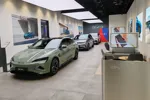Modern automotive dealerships are much like any other retail environment. Not only must they contend with an increasingly complex and fragmented path to purchase and growing competition from online, but they also face an all-too familiar challenge: delivering a consistent brand experience across entire retail estates, writes Colin Chapman, operations director of CJ Retail Solutions.
We recently visited a selection of premium automotive dealerships to assess the status of their current retail display standards. Standing alongside some of the famed marques in the industry was, in many ways, automotive heaven. In retail display terms, however, the experience left us with very mixed feelings.
Communicating brand heritage was a key theme within all of the dealerships we visited. Rolls Royce brought this to life through a combination of aspirational prints of famous and iconic names from the world of film and music and a carefully curated selection of books, detailing the life and times of the brand.
Meanwhile, Bentley focused on its motor racing legacy – from early 1930s racers, all the way through to more recent Le Mans success. There was also a driving simulator, complete with a Top Gear inspired leader board. Range Rover and Land Rover incorporated a feature wall showcasing black and white images to reinforce its unique blend of rugged off-road prowess and stately presence.
Despite boasting a motor racing heritage to challenge Bentley, its communicative value within the Jaguar dealership we visited was subtle to say the least – limited to just a single example of a liveried Jaguar sports car that, under brand guidelines, was not allowed to share floor space with Jaguar’s latest road-going descendent.
BMW’s focus as a brand is very much on cutting-edge technological innovation, with its much-publicised new i3 and i8 electric-powered models. However, the presence of a gleaming 1990s Z1 created a strong focal point that reinforced the brand’s longstanding ‘forward-thinking’ credentials.
Inconsistent and poorly maintained
Looking specifically at the retail displays, as you would expect, most luxury dealers we visited opted for a minimalist approach to POS, with smart display stands located alongside cars. Yet whilst these provided an opportunity for extras and deals to be communicated to shoppers more effectively than plastering POS all over the car – which can be confusing to digest – standards of POS activation were largely inconsistent.
Brand consistency was also a common issue, particularly in relation to dealer produced in-store communication – with layout, typography and imagery rarely templated to deliver a uniform brand experience. BMW was perhaps the lone exception, delivering a much more coordinated and corporate feel.
Poorly maintained POS or missing product and environmental information were visible in almost all dealerships, along with incorrect and illogically sited retail displays. In some instances, damaged POS was even left prominently on display to greet customers as they entered the showroom.
Elsewhere, incomplete material and finish samples were also evident. Surprisingly, this is an area in which the BMW dealership fared poorly, with over 80% of samples missing on the display we saw, although standards within other dealerships were also below the expected standard.
With shoppers living increasingly digital lives they expect brands they buy from to do the same. As a result, the integration of digital retail display solutions is becoming increasingly prevalent in automotive dealerships – as you would expect given the trend towards greater tech integration within vehicles themselves.
More and more car retailers are beginning to integrate iPad’s into their retail displays, as was evident at BMW, allowing the customer to swipe through much more information without having to go and find a salesperson straight away. But whilst Information stands and interactive terminals are seemingly the order of the day, maintaining compliance standards is often not.
As our visits highlighted, it’s important to make sure that these large capital expenditure investments work. Clever tech and well-considered creative content counts for nothing if the digital screens and devices are not switched on. We came across an augmented reality (AR) solution that had been removed from the showroom floor – though shoppers were still being directed to the space where it used to be – and numerous digital screens and tablet devices that were not working.
Whilst our visits may not be representative of shopper experiences across the UK, they were indicative of the disconnect that exists up and down the country in terms of how retail brand delivery is managed. They also highlighted that even premium brands are not immune to the challenges of delivering best practice retail standards.
A common mistake made is to only critique the most prominent and tangible elements that go into the buying process, such as customer service. It is essential to look beyond this obvious touchpoint and investigate how dealerships manage every aspect of brand delivery. It is the pragmatic day-to-day business of reinforcing brand perception through retail standards that feeds into customer behaviour in the reality of the selling situation.













Login to comment
Comments
No comments have been made yet.